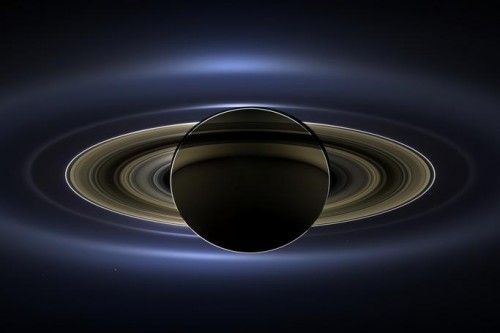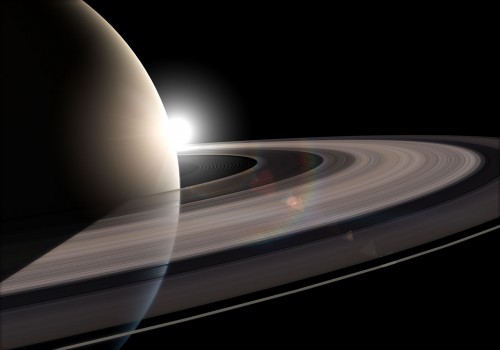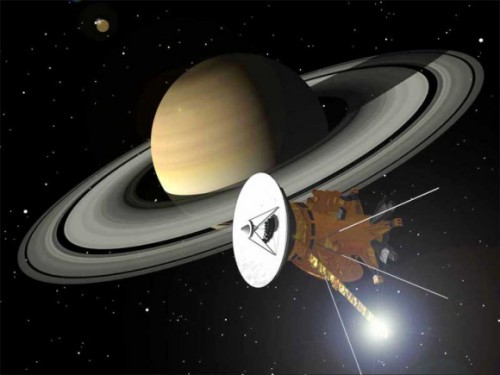
The origin of Saturn’s rings has been one of the most interesting puzzles in planetary science, and now new data from the Cassini spacecraft is helping to fill in the pieces, showing that the majestic ring system is very ancient, probably as old as Saturn itself.
The new findings were presented Aug. 15 at the Planetary Rings Workshop in Boulder, Colo. They appear to support the theory that the ring system is very old and probably formed at the same time that Saturn itself did, about 4.5 billion years ago, rather than being younger, as some other theories have suggested.

So, how did scientists arrive at this conclusion? They measured the rate at which dust (or micrometeoroids) from outside the Saturn system is entering the rings and “polluting” them. It turned out that rate is about 40 times lower than previously thought, which supports the “old rings” theory; it negates the argument against that theory, which said that if the rings were that old, the ring material should have become coated with the darker dust particles by now. This measurement allows the rings to be much older and still appear the way they do.
“The rings can be three to ten times older than we used to think,” said Larry Esposito, a planetary scientist at the University of Colorado, Boulder.
The dust particles were collected by Cassini’s Cosmic Dust Analyzer (CDA) instrument over the past seven years. Only 140 dust particles were captured, and their trajectories indicated that they originated from outside the Saturn system, and they were big enough to “dirty” the ring system if there were enough of them.
The results were surprising, as Cassini scientists had been expecting to see a much higher rate of dust deposition. Those estimates, however, were based on dust influx from the inner Solar System. The dust particles are thought to originate from much farther out in the Solar System, in the Kuiper belt. As Sascha Kempf, a space physicist also at the University of Colorado, said, “We’re seeing very, very different stuff.”

While promising, the results aren’t proof yet; it is still possible that the rings are younger, formed from previous moons ripped apart by Saturn’s gravity. “But I’m more inclined to believe the old-rings model now than before,” said Jeff Cuzzi, a planetary scientist at NASA’s Ames Research Center in Moffett Field, Calif. According to Esposito, it is also possible that there used to be more dust in the early Solar System than there is now, or that the rings go through a “recycling” process which keeps them looking relatively fresh.
Cassini is expected to keep operating until at least 2017 and has, since 2004, revolutionized our understanding of Saturn and its many moons. It has mapped at least 101 water vapor geysers on the tiny moon Enceladus, providing more evidence for a subsurface ocean there, similar to Jupiter’s moon Europa. It has also revealed Saturn’s largest moon Titan to be another of the most fascinating places in the Solar System, with a subsurface ocean as salty as the Dead Sea on Earth and lakes, seas, rivers, and rain of methane on the surface. The Saturn system is like a mini Solar System in and of itself.
What else will Cassini discover? Only time will tell, but there are probably more surprises in store, especially for subsequent missions which will continue where Cassini leaves off.
Want to keep up-to-date with all things space? Be sure to “Like” AmericaSpace on Facebook and follow us on Twitter:@AmericaSpace




Fascinating article and yet another reason why exploration of the Jupiter/Saturn planets and moons must be a scientific and technological priority. One wonders if a “sample return” mission to Saturn’s rings is feasible? We have the technology!
Interesting to think that Saturn’s rings might come from space dust. But to me it begs the question “Why” the other large planets would not have rings that are similar size and scope to Saturn’s. What makes Saturn so special that its rings are so much more prominent than Jupiter’s and Uranus’s?
EL: very interesting point! I never considered it. However, I wouldn’t be surprised if one day we do indeed discover another “Saturn.” Perhaps the distances are too great to detect ring systems with current technology.